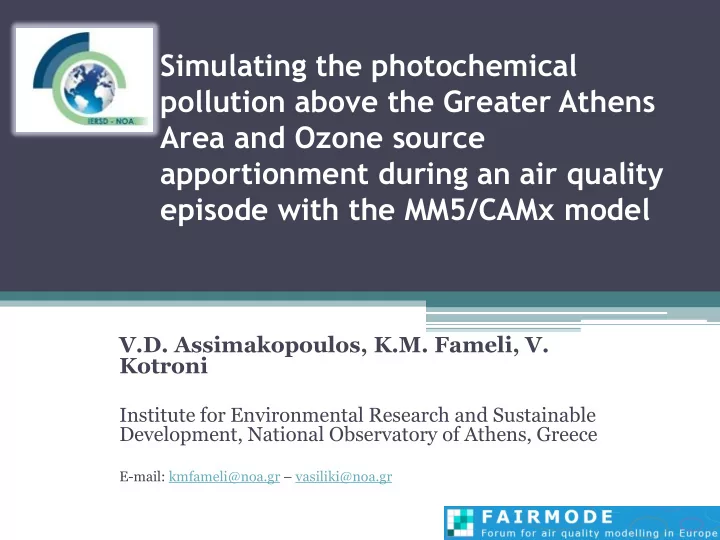

Simulating the photochemical pollution above the Greater Athens Area and Ozone source apportionment during an air quality episode with the MM5/CAMx model V.D. Assimakopoulos, K.M. Fameli, V. Kotroni Institute for Environmental Research and Sustainable Development, National Observatory of Athens, Greece E-mail: kmfameli@noa.gr – vasiliki@noa.gr
Introduction The Greater Athens Area (GAA) has undergone significant FAIRMODE Technical Meeting, Athens 19-21 June 2017 changes. Despite measures taken photochemical and particulate air pollution episodes continue to occur. Few modelling studies exist due to the lack of up-to-date, accurate and detailed emission inventory. Construction of the Flexible Emission Inventory for Greece and the GAA (FEI-GREGAA) from 2006 – 2012.
Objectives Simulations with the MM5/CAMx modeling system for typical photochemical and particulate pollution summer episodes in the GAA. Study the dispersion characteristics of pollutants above the GAA. Estimate the impact of different sources on the formulated pollutant levels. Compare the modelled results with real time measurements.
Region - Study Area Characteristics
Background information O3, NOx and PM data from the Athens Air Quality Monitoring Network, Mesogeia and Thriassion Plains were analysed from 2003 – 2012. Stations characterisation was Urban Traffic, Suburban, Urban Background, Suburban Background, Industrial O3 mean annual concentrations have been rising in the suburban background stations (from 69 to 81μg/m3). More episodes occur there especially during the summer. Almost constant and lower in the Athens basin (58 to 61μg/m3) Ozone episodes continue to appear, may vary in duration and be in parallel with PM.
Background information ΝΟ ₂ pollution episodes occurred until 2009 throughout the year except in August in traffic stations. Ο ₃ pollution episodes are frequent in peripheral stations, especially in the warm period with no decreasing trend. PM 10 pollution episodes occur throughout the year across the GAA and may last for several days. The most persistent occurred in 2007 and 2008. All episodes are associated with low wind speeds of southerly or southwesterly direction mainly. High temperatures lead to higher O 3 levels.
Background information Evolution of NO 2 levels above the GAA ( μ g/m 3 ) Evolution of PM 10 levels above the GAA ( μ g/m 3 ) Evolution of O 3 levels above the GAA ( μ g/m 3 ) Evolution of CO levels above the GAA (mg/m 3 )
Background Information ΝΟ ₂ pollution episodes occurred until 2009 throughout the year except in August in traffic stations. Ο ₃ pollution episodes are frequent in peripheral stations, especially in the warm period with no decreasing trend. PM 10 pollution episodes occur throughout the year across the GAA and may last for several days. The most persistent occurred in 2007 and 2008. All episodes are associated with low wind speeds of southerly or southwesterly direction mainly. High temperatures lead to higher O 3 levels.
Methodology- Description of F .E.I.-GREGAA F.E.I. - GREGAA (Flexible Emission Inventory for Greece and the GAA) Period: 2006-2010, Spatial and temporal scale: 6x6km 2 for Greece and 2x2km 2 for the GAA , 1hour Methodology: EMEP/EEA Emission Inventory Guidebook 2009 and 2013 for 10 SNAP levels: SO 2 , NO x , CO, PM 10 , PM 2.5 , NMVOCs, VOCs, NH 3 and CO 2 . Annual emissions: Official, accurate, analytical data (traffic fleet, airplane fleet etc.) Spatial and temporal allocation: proxy values per source category (degree of urbanization, population density, updated land use, road types and seaways).
Methodology- Description of F .E.I.-GREGAA Annual variation of emissions in Greece and the GAA
Methodology – Initial and Boundary Conditions Model: Comprehensive Air quality Model with extensions – CAMx emission, dispersion, chemical reaction and removal of pollutants in the troposphere. Domain: Three nested grids of resolution18 × 18, 6 × 6 and 2x2 km 2 covering Europe, Greece and the GAA, respectively. Simulation period: (two-day spin), 00.00 UTC 10/6/2010 to 24.00 UTC 20/6/2010 Meteorological Inputs: temperature, wind, pressure, humidity, and cloud/rain) by Mesoscale Meteorological Model MM5. Initial and boundary conditions: 50 ppb for O 3 , 0.1ppb for NOx, 200ppb for CO and 1.5 ppb for SO 2 . Chemistry: Carbon Bond (CB06)-CF mechanism
Methodology - Air Quality Conditions Ozone and particulates daily variations during the modelled period
Methodology – Meteorological Conditions 6.00LST 12.00LST 15.00LST 21.00LST 13 13
Results Comparison of the modeled (black line) and observed (red line) wind speeds at the NOA stations across the GAA
Results O 3 – 14/06/2010 12.00LST 15.00LST 16.00LST 18.00LST O 3 – 19/06/2010 09.00 LST 12.00LST 15.00LST 20.00LST
Results – Comparing simulations with measured data Northern suburbs Southern suburbs
Results – OSAT analysis
Results – OSAT analysis Contributions to O 3 concentration by source region at the receptor cell at 14:00
Conclusions The spatial disaggregation of emissions showed that the centre and suburbs are burdened with high CO, NOx, and PM 10 emissions. Further development of the emission inventory to add biogenic emissions and update emission factors using targeted measurements. Comparison of CAMx results with measurements revealed a satisfactory agreement for the urban and rural stations. The O 3 plume penetrated the interior of the basin with the aid of the sea breeze mechanism.
Conclusions The character and concentration levels of the photochemical and particulate pollutants have not presented a significant decrease even though on average the emissions of primary pollutants have decreased. Different regions contribute to the ozone levels, the central and suburbs being significant. The air quality management of such a complex area requires the deep understanding of the impact of all sources with the combined effect of meteorology.
Conclusions Purpose: Short term air quality forecasting for Greece and Athens (in 2018) Pilot stage, comparison with AQMN data. Use FAIRMODE tools to ensure good quality of results and move to planning……
Thank you! kmfameli@noa.gr – vasiliki@noa.gr
Recommend
More recommend